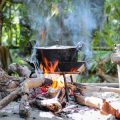Introduction to British Bushcraft Cooking
Embarking on the art of campfire cooking in the UK is more than just preparing food outdoors—its about embracing centuries-old traditions, resourcefulness, and a deep connection with the land. British bushcraft cookery merges practical skills with heritage recipes, transforming simple ingredients into hearty meals under open skies. Whether nestled in a woodland glade or beside a windswept moorland, the experience of crafting traditional British dishes over an open flame is both nostalgic and rewarding. At its heart, this style of cooking relies on a few essentials: robust cast iron cookware, trusty fire tongs, and a seasoned billy can or kettle for brewing that all-important cuppa. Mastering these basics sets the stage for recreating classic British fare—from sizzling sausages and baked potatoes to rich stews and damper bread—all imbued with smoky flavours unique to the great outdoors. As we delve into this guide, you’ll discover how British outdoor culinary culture marries practicality with tradition, ensuring every meal around the campfire is as memorable as it is delicious.
2. Campfire Safety and Setup: A British Perspective
When it comes to mastering campfire cooking in the British countryside, safety and environmental respect are top priorities. The UK’s varied landscapes—from the Lake District to the Scottish Highlands—demand a careful approach to setting up a traditional bush campfire. Here’s a practical guide to building, maintaining, and extinguishing a safe campfire while preserving the beauty of the local environment.
Choosing the Right Spot
Always select a flat, open area away from overhanging branches, dry grass, or peat-rich soil (which can catch fire underground). It’s best to use established fire pits where available—many popular walking and camping spots provide designated spaces for fires.
| Checklist for Safe Campfire Location | Why It Matters |
|---|---|
| Away from tents and gear (at least 5 metres) | Prevents accidental fires spreading |
| Clear of flammable debris (leaves, twigs) | Reduces risk of sparks igniting surroundings |
| Sheltered from wind | Keeps flames controlled and manageable |
| Near a water source (but not too close to riverbanks) | Water for extinguishing; avoid damaging delicate habitats |
Building Your Campfire: British Method
The classic “criss-cross” or “log cabin” style is ideal for even heat and easy control—perfect for preparing hearty British recipes like toad-in-the-hole or jacket potatoes. Use locally sourced deadwood (never cut live branches) and start with kindling such as dry twigs or natural firelighters. Remember, bringing your own fuel helps protect sensitive environments.
Essential Fire-Building Steps:
- Create a ring of stones to contain your fire.
- Lay kindling in the centre, then arrange small sticks in a teepee or log cabin pattern around it.
- Add larger logs gradually once the kindling is burning well.
- Keep your fire small—a modest flame is all you need for most bush recipes.
Respecting Wildlife and Countryside Code
The British countryside is home to diverse flora and fauna. Always follow the Countryside Code: leave no trace, take all rubbish with you, and never disturb wildlife. Avoid using soaps or chemicals near water sources. After cooking, fully extinguish your fire using water—not just soil—and scatter cold ashes away from paths and habitats.
| Top Tips for Responsible Campfire Cooking |
|---|
| Check local fire bans before lighting up—especially during dry spells in summer. |
| Minimise impact: use portable grills if fires are discouraged. |
| Never leave a fire unattended—even briefly! |
| If in doubt, ask local landowners or rangers about fire regulations. |
In Summary:
A safe, well-managed campfire is at the heart of traditional British bush cooking. By following these practical steps, you’ll enjoy authentic outdoor meals while preserving Britain’s natural heritage for future generations.

3. Classic British Breakfasts by the Fire
Step-by-Step Guide: The Ultimate Campfire Fry-Up
No British bush experience is complete without a hearty fry-up cooked over an open flame. Begin by setting your campfire to a medium heat and place a sturdy cast iron pan over the embers. Add locally sourced bacon rashers and let them sizzle until crisp at the edges. Next, crack free-range eggs directly into the pan, letting them cook in the bacon fat for that unmistakable flavour. Toss in thick-cut sausages from a nearby butcher, turning regularly until golden brown and cooked through. For an authentic touch, add grilled tomatoes and mushrooms picked from local markets, letting them soften and absorb those smoky aromas.
Black Pudding: A True Taste of Britain
Black pudding may be divisive, but when prepared fresh over a campfire, it becomes a true bush delicacy. Slice the black pudding into generous rounds and lay them gently in the pan once your bacon is nearly done. Allow each side to crisp up for 2-3 minutes, so you get that irresistible crunch outside while keeping the inside soft and rich. Pair with crusty bread toasted briefly on the grill—just close enough to the fire to pick up a hint of smokiness.
Campfire Tea: The Quintessential Companion
No breakfast would be complete without a proper cuppa. Boil fresh water in a kettle suspended above the flames or nestled among hot coals. Add loose-leaf English Breakfast tea (or your favourite blend) to a pot, pour over boiling water, and steep for 3-5 minutes. Serve with fresh milk collected from a local farm if available, and enjoy that comforting warmth as you take in the morning air.
Pro Tips for Success
Always use locally sourced ingredients where possible—not only does this support rural communities, but it also ensures maximum freshness and flavour in every bite. Remember to control your campfire’s heat carefully; too hot and you’ll burn your breakfast, too cool and it’ll never get that classic crispy finish. With these steps mastered, you’re guaranteed a breakfast that rivals any high street café—all enjoyed right at your wild campsite.
4. Hearty Mains: Traditional British Lunches and Suppers
When it comes to campfire cooking, nothing beats a hearty British main meal after a long day outdoors. Classic recipes like toad-in-the-hole, beef stew, and fish and chips bring comfort and nostalgia straight to your campsite. These dishes are not only filling but also surprisingly simple to adapt for the bush, using straightforward techniques and minimal kit.
Toad-in-the-Hole: A Campfire Classic
This Yorkshire favourite, traditionally made with sausages baked in a fluffy batter, is perfect for open-fire cooking. For a bush-friendly version, cook quality British bangers over the flames until browned, then pour over pre-mixed batter in a cast iron skillet. Cover with foil or a lid, and set on hot embers until golden and risen. Serve with caramelised onions and a splash of brown sauce for that authentic touch.
Beef Stew: The Ultimate One-Pot Wonder
Beef stew is ideal for slow-cooking over a campfire. Start by browning chunks of beef in a heavy pot, then add root veg like carrots, potatoes, and parsnips. Stir in some stock, a dash of ale, and classic herbs like thyme or bay leaf. Let it simmer gently while you enjoy the outdoors—the longer it cooks, the richer the flavour. Here’s a quick breakdown:
| Ingredient | Campfire Tip |
|---|---|
| Diced beef | Browns best on high heat—use direct flames first |
| Root vegetables | Chop evenly for even cooking |
| Stock/ale | Add gradually; top up if stew gets too thick |
Fish and Chips: Crispy Treats Without the Fryer
No need for a deep fryer in the wild! Wrap white fish fillets (like cod or haddock) in foil with lemon, salt, and pepper—cook directly on embers for that flaky texture. For chips, slice potatoes into wedges, toss with oil and seasoning, then roast them in a pan over the fire or wrap them in foil packets. It’s traditional to serve these with malt vinegar or tartare sauce—bring along a small bottle for authenticity.
Bush Adaptations: Making It Work Outdoors
Outdoor cooking means improvisation. Cast iron pans are your best mate for even heat, while foil packets make clean-up easy. Pre-mix batters at home in bottles or bags for less faff at camp. Don’t forget to pack staple British condiments—a squirt of HP Sauce or dollop of English mustard brings these classics to life.
5. Sweet Treats: Puddings and Bakes in the Outdoors
If you think you have to forgo your favourite British desserts while camping, think again. With a bit of ingenuity, you can whip up classic sweet treats like sticky toffee pudding and scones right over the campfire. Here’s how to bring a taste of home to the great outdoors with these comforting puddings and bakes.
Sticky Toffee Pudding – The Campfire Way
Sticky toffee pudding is a beloved British dessert, renowned for its rich flavour and gooey texture. For a campfire version, prepare your batter at home by mixing dates, butter, brown sugar, eggs, self-raising flour, and a splash of vanilla extract. Store it in a sealed container until you’re ready to bake. At your campsite, grease a heavy-based pan or Dutch oven with butter. Pour in the batter, cover with foil or the lid, and place it over gentle embers rather than direct flames. Rotate occasionally for even baking. Meanwhile, make a simple sauce by melting more butter with brown sugar and a dash of double cream in a small pan. Once the pudding is cooked through (about 25-30 minutes), drizzle the warm sauce on top and serve straight from the pan for that rustic charm.
Scones on the Fire – An Afternoon Tea Classic
No British outdoor feast would be complete without freshly baked scones. Mix self-raising flour, cold butter, sugar, and milk at home – keep it chilled in a cool bag. At camp, quickly knead the dough and shape into rounds. Place them in a greased skillet or Dutch oven, then set over hot coals with the lid on top to mimic an oven effect. Flip once during baking for an even golden crust. In about 15 minutes, you’ll have warm scones ready to split open and slather with clotted cream and jam – just don’t forget to pack these essential accompaniments!
Tips for Successful Campfire Baking
- Always use indirect heat for puddings and bakes to prevent burning.
- Pre-measure ingredients at home for convenience.
- A cast iron skillet or Dutch oven is ideal for even heat distribution.
- Don’t lift the lid too often; this keeps the heat steady inside.
Bringing Tradition to the Bush
Baking classic British desserts outdoors isn’t just possible – it’s deeply satisfying. With basic kit and some clever prep, you can end your day in the bush with sticky fingers and big smiles all round. These timeless recipes prove that British comfort food belongs around any campfire.
6. Foraging and Sourcing Local Ingredients
One of the joys of mastering campfire cooking in the British countryside is making the most of what nature provides. Not only does foraging add an authentic touch to traditional recipes, but it also deepens your connection with the land and seasons. Here’s a practical guide to safely sourcing and using local produce while out bushcrafting or wild camping.
Safety First: The Golden Rules of Foraging
Before you pick anything, always remember: if in doubt, leave it out. Use reputable field guides or apps suited for Britain’s flora and fungi, and never eat anything you can’t positively identify. Stick to areas where foraging is permitted—respecting private property and protected sites is key. And, crucially, only take what you need so that plants continue to thrive for wildlife and future foragers alike.
Seasonal Highlights: What to Look For
Spring
Wild garlic carpets ancient woodlands with its unmistakable aroma—ideal for soups or as a punchy pesto stirred through campfire-cooked potatoes. Young nettle tops can be used like spinach in broths or bubble & squeak.
Summer
Berries come into their own: blackberries along hedgerows, wild strawberries hidden amongst grasses, and elderflowers perfect for fragrant cordials. Meadows are dotted with sorrel and wild herbs—great for adding freshness to stews or grilled meats.
Autumn
This is mushroom season, but only forage fungi if you’re experienced or accompanied by a knowledgeable guide. Sloes and crab apples are ripe for picking, ideal for jams or flavouring campfire-baked desserts.
Winter
Pickings are slimmer, but rosehips make a vitamin-rich syrup and chestnuts (in parks or woods) can be roasted on embers—a classic British winter treat.
Practical Tips for Campfire Cooking with Wild Ingredients
- Always wash finds thoroughly before use.
- Add wild greens near the end of cooking to preserve their flavour and nutrients.
- Bring basic seasonings (salt, pepper) to enhance the natural tastes of your foraged ingredients.
A Note on Sustainability
Sustainable foraging means leaving roots intact, taking only what you’ll use immediately, and avoiding rare or endangered species. This keeps Britain’s countryside abundant—and ensures there’s plenty left for your next adventure under the stars.
7. Practical Tips: Cleaning Up and Leaving No Trace
One of the hallmarks of British outdoor cooking is a deep respect for nature. After enjoying your campfire feast, it’s crucial to follow best practices for sustainable camping and leave your site as you found it—or even better. Below are some practical tips rooted in British tradition, ensuring that your bushcraft culinary adventures are kind to the countryside.
Smart Cleaning Routines
Begin by scraping off any food remnants from pots and pans using natural materials like twigs or moss, which can then be burned safely on the fire. For washing up, use biodegradable soap sparingly and carry out your cleaning at least 50 metres away from streams or lakes to avoid contaminating water sources. A simple scrubbing brush and a collapsible basin make light work of most cleaning tasks, keeping your kit tidy without leaving a mark on the land.
Responsible Waste Disposal
All rubbish—including food scraps—should be bagged up and taken home with you. The British countryside code is clear: “Leave no trace.” Avoid burning plastics or foil as these can release toxins; only burn untreated wood and paper products when disposing of waste in the fire. If composting toilets aren’t available, bury any biodegradable waste in a small hole at least six inches deep, well away from footpaths and water.
Respect Local Wildlife
Leftover food can attract animals, which disrupts local ecosystems and teaches wildlife to rely on humans. Store all provisions securely overnight and check your surroundings thoroughly before packing up to ensure nothing has been left behind—even something as small as a tea bag or apple core can harm the environment.
Final Sweep and Departure
Before leaving, do a careful sweep of your campsite. Douse any remaining embers with plenty of water until cold to touch—never simply cover with soil. Scatter any unburned wood back into the forest and restore disturbed ground by replacing turf or leaf litter. These time-honoured practices not only protect our beloved British landscapes but also set an example for future generations of outdoor cooks.


